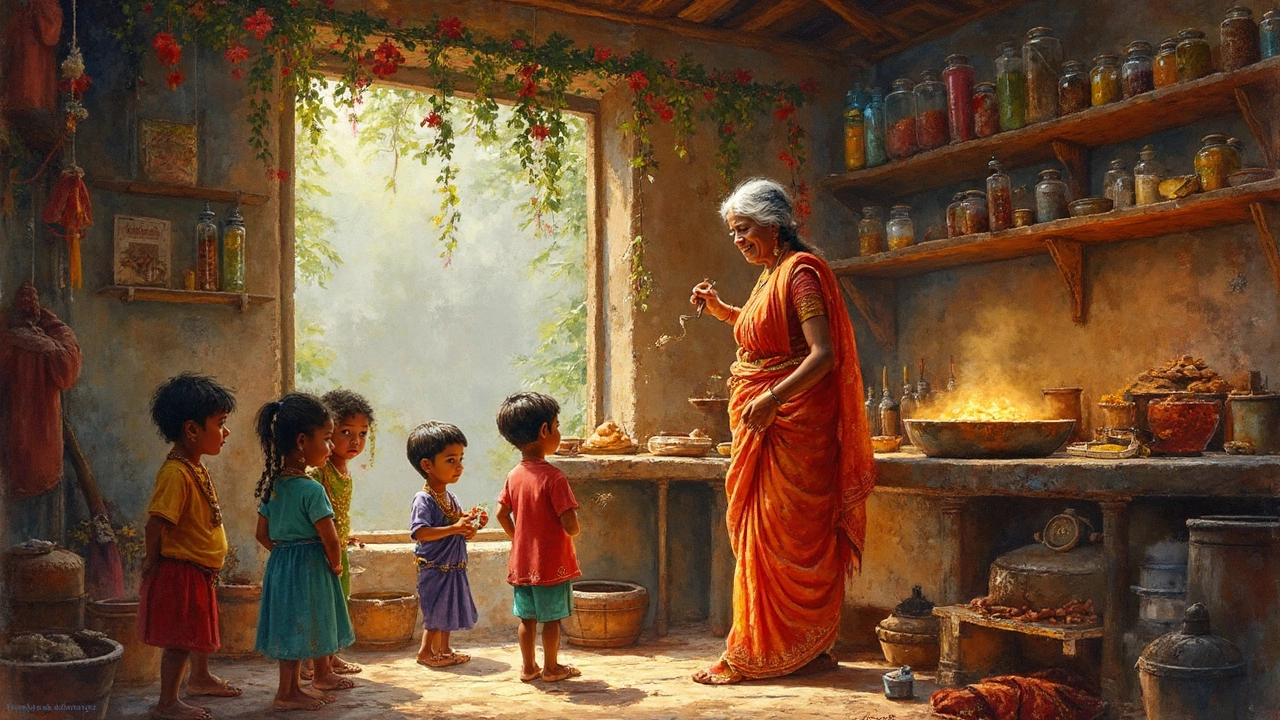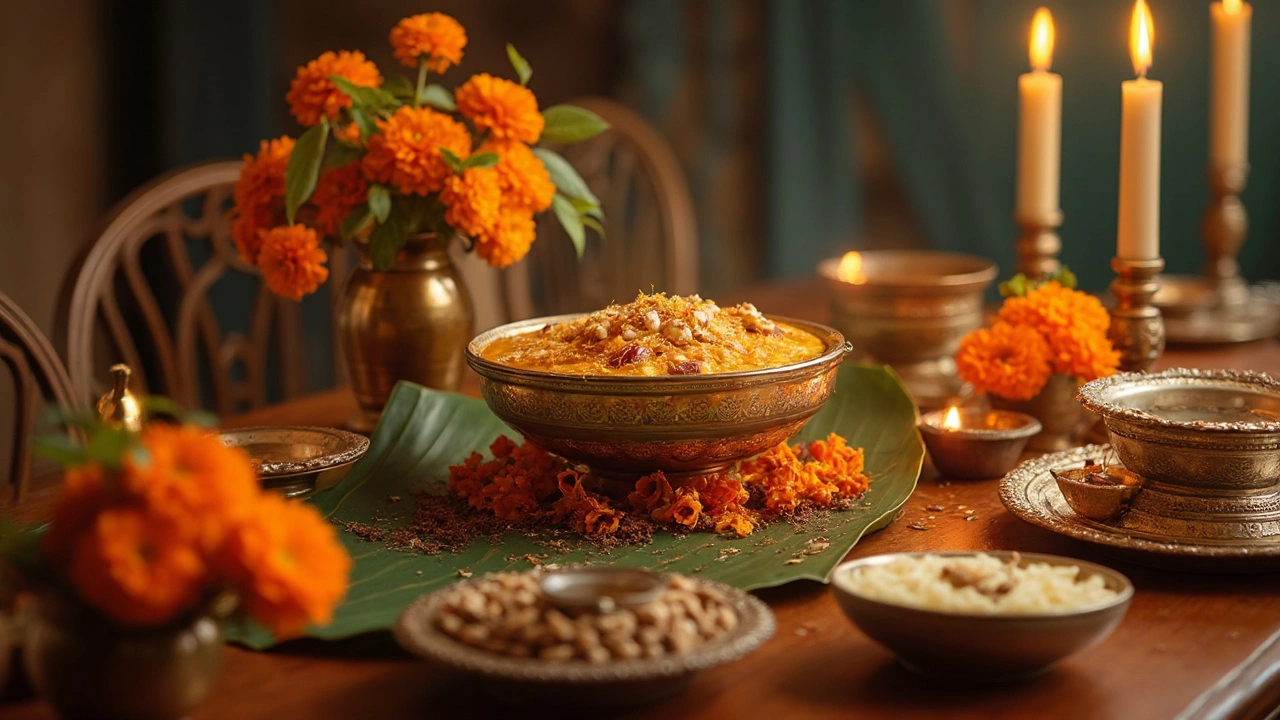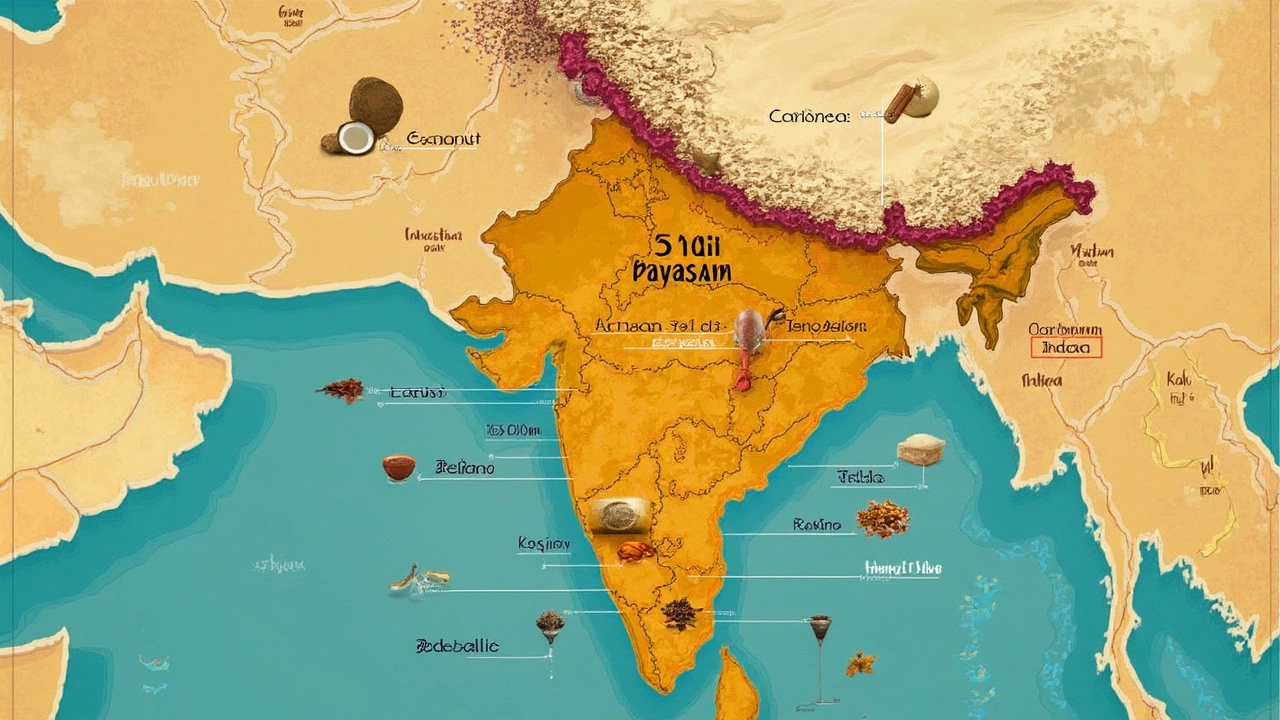Discover India's Oldest Dessert: The Mythical Payasam
 Mar, 19 2025
Mar, 19 2025
If you've got a sweet tooth and a curiosity about ancient culinary delights, then you're in for a treat with Payasam, often touted as India's oldest known dessert. This sweet dish, brimming with history, traces back centuries, cemented in India's culinary traditions. Imagine a dessert made with basic ingredients like rice, milk, and sugar or jaggery. Sounds straightforward, right? But don't let its simplicity deceive you. Each spoonful of Payasam is a testament to the art of creating remarkable flavors with humble ingredients.
You'll often find Payasam at the heart of Indian festivals and religious ceremonies. One of the most fascinating aspects of Payasam is its regional variations. Whether it's called Payasam in the South, Kheer in the North, or any other name across different states, each version brings a unique flavor profile to the table. The dish's subtle enhancements—like adding cardamom, cashews, or raisins—highlight the diverse culinary touch of each region.
The Origin of Payasam
When you dig into the history of Payasam, it feels like stepping into a time machine that takes you back to ancient India. The journey of this sweet treat begins in the sacred temples of the Indian subcontinent, where it was originally prepared as an offering to the deities. It goes way beyond just a delicious end to a meal, carrying with it stories and traditions that have been passed down through generations.
In historical records, Payasam is often mentioned in connection with temple rituals, where it was served as 'prasadam', a religious offering shared among the devotees after being blessed. Interestingly, references to variations of Payasam appear in ancient texts such as the Tamil Sangam literature, highlighting its presence since the early centuries of the common era.
"The recipe for Payasam has remained largely unchanged over the centuries, reflecting its timeless appeal and cultural significance," – Dr. Anita R. Ratnam, Cultural Historian.
While many associate Payasam primarily with South India, its reaches and variations span across the country. In North India, it's more commonly known as 'kheer', yet the essence remains the same.
The Temple Connection
The relationship between temples and Payasam is further interesting. Each temple had its unique recipe variation, often tweaking slight ingredients to lend their version of the dessert a distinctive taste. The Ambalapuzha temple in Kerala, for instance, is particularly famous for its version known as 'Ambalapuzha Pal Payasam'.
| Temple | Specialty Payasam |
|---|---|
| Ambalapuzha | Pal Payasam |
| Sabari Mala | Aravana Payasam |
These regional specialities not only highlight the rich diversity of Indian cuisine but also how food strengthens cultural and religious connections over time.

Ingredients and Method
Crafting Payasam might seem like an art, but it’s quite a straightforward process once you’ve got the basics down. Here, we'll walk you through what you need and how to whip up this traditional delight right in your kitchen.
Ingredients
- 1/2 cup of rice (traditionally, short-grain rice is ideal)
- 4-5 cups of milk (full-fat gives the creamiest texture)
- 1/2 cup of sugar or jaggery (jaggery offers a rich, earthy sweetness)
- 2 tablespoons of ghee (clarified butter)
- A pinch of cardamom powder for that classic aroma
- Handful of cashews and raisins (for garnish)
Method
- Start with washing the rice under cold water until the water runs clear. This helps remove excess starch.
- In a thick-bottomed pan, heat the ghee over medium heat. Add the cashews and raisins till they are golden brown. Remove and set aside—these will be your garnishes.
- In the same pan, add the rinsed rice and sauté it lightly in the remaining ghee for a couple of minutes. This gives an extra nuttiness to the dish.
- Pour in milk, and bring it to a boil, stirring occasionally to prevent it from sticking to the bottom.
- Once the milk starts boiling, lower the heat and let it simmer. Cook until the rice is soft and the milk reduces to about half its original volume.
- Add the sugar or jaggery—not only does it sweeten the dish, but using jaggery lends it a deep, caramel flavor, which is very traditional.
- Finally, add cardamom powder for the aroma and drop in your prepared cashews and raisins.
- Stir everything well. At this point, a divine aroma should fill your kitchen!
And that's how you make this classic Indian dessert! Serve it warm or chilled, according to your preference.
| Nutritional Info (per serving approx.) | |
|---|---|
| Calories | 300 |
| Fat | 12g |
| Carbohydrates | 45g |
| Protein | 6g |
This indulgent dessert is a perfect way to end a meal and is sure to impress your family and friends with its rich taste and aromatic blend.

Regional Variations
India's diverse culture shines through in its food, and the Payasam is no exception. This sweet dish, known by various names across the country, varies significantly in preparation and taste from one region to another.
North India: The Kheer Staple
In the northern parts of India, the dish is commonly known as Kheer. It typically involves slow-cooking rice with milk and sugar, enhanced by flavors like cardamom and saffron. Some families add a crunchy touch with almonds and pistachios. Fun fact: in Punjab, cutting the milk with a bit of rose water gives it an exciting aromatic twist.
South India: A Coconut Milk Twist
Head down south, and you'll meet the classic Kerala-style Payasam, usually made from jaggery, giving it a deep caramel flavor profile. Instead of dairy milk, coconut milk is often used, offering a creamy and rich texture that's just unforgettable. Don't be surprised if you find versions with dal (lentils) or even spices like black pepper.
East and West: The Unsung Heroes
In the east, particularly in Bengal, Payasam takes the form of 'Payesh,' made with Gobindobhog rice, which is small-grained and aromatic. It's a centerpiece in Bengali wedding menus. Meanwhile, in Maharashtra in the west, Puran Poli - a flatbread stuffed with sweetened dal - is often paired with a thin, soupy version of Payasam called 'Basundi.'
Stats Worth Noting
| Region | Main Ingredient | Unique Addition |
|---|---|---|
| North | Rice | Saffron |
| South | Coconut Milk | Jaggery |
| East | Gobindobhog Rice | Bay Leaves |
| West | Puran Poli | Cardamom |
These variations not only please the palate but also reflect the regions' cultural richness and adaptability. So the next time you talk about Indian dessert, remember, what you're savoring is not just a dish but a bite of history and diversity.
Leah Schwabuaer
March 25, 2025 AT 14:48Wow, Payasam sounds amazing! I’ve never tried it, but it seems like such a sweet and rich dessert. 🍮 I’ve heard there are so many variations based on the region. Does anyone have a favorite recipe or variation to share? I love learning about different cultures through food.
It’s kinda wild to think about how much history is wrapped up in just a dessert, right? The rituals and celebrations that accompany such a dish must have so much meaning. I’ve always admired how desserts across different cultures tell stories about traditions.
By the way, is there a specific occasion in India where Payasam is practically a must-have? It would be cool to hear how this dessert fits into festivals or holidays! 🍽️
Ferdie MP
March 25, 2025 AT 14:49Payasam really puts a spotlight on the simplicity of Indian cuisine. The ingredients are so basic, yet they create something rich and flavorful. It makes you think about how we can craft great dishes with minimal resources. That’s true culinary artistry if you ask me!
What’s even more intriguing is how it’s a staple for festivals. Food has a way of binding traditions and cultures together, doesn’t it? I wish more celebrations in the West had similar food-centered focus.
I’m curious about the different types of Payasam too. Are some spices or ingredients regional? Would love to hear from those who've tried making it at home!
Frances Ferguson
March 25, 2025 AT 14:53Honestly, Payasam sounds overrated. I mean, a dessert made primarily from milk and rice? It’s nice, but doesn't it get a bit mundane? You can’t deny the cultural importance of it, but it's really not that exciting. 😒
There’s a ton of desserts out there that have more complexity and flavor. When I think of dessert, I want something that really packs a punch. But I guess it has its place in the traditions of India.
What annoys me is how it's always featured at celebrations. Are there really no better options to showcase India's culinary edge? I think desserts should evolve, not just be tied to tradition.
Isabella Gully
March 25, 2025 AT 14:56Hey all! Can I just say how much I LOVE the festive vibes around traditional desserts like Payasam? 😍 There’s something so comforting about enjoying these sweet treats with friends and family during special occasions. It's sweet and lovable and encapsulates all the warmth and love of Indian hospitality!
I’d love to give making Payasam a shot in my own kitchen. I heard there are some tricks to making it perfectly creamy and sweet. Anyone willing to dish out some secrets? Or is the taste better when someone from the culture makes it?
Do people ever include nuts or fruits in their recipes? Sometimes the creativity in desserts can make them even more delightful! 🎉
Leanne Bush
March 25, 2025 AT 14:59OMG, Let’s just appreciate the cultural significance of Payasam for a moment. This isn’t just about a dessert; it’s a tradition that dates back ages! 🍚💖 Having it during various celebrations and festivals adds so much value to our social gatherings.
I love how food can evoke such powerful memories. Whenever I think of childhood festivals, Payasam pops up! Has anyone else had a similar experience? Food truly has a unique power to weave memories together.
Isn’t it wild to think this dish transcends generations? I’m curious, what is the most unconventional version of Payasam anyone has ever tried? 😄
Justin Lemieux-Reale
March 25, 2025 AT 15:03Payasam is one of those dishes that takes me back to my roots. Growing up, we always had it during major festivals, and the smell of it cooking would fill the house. It’s a delightful reminder of simpler times. 😌✨
Also, can we talk about how adaptations in different regions give it a unique twist? I think it’s fascinating how this dessert changes from place to place, yet it still holds the same core essence. Who knew rice and milk could give rise to such diversity? That’s culinary magic right there.
For anyone who hasn't experienced it yet, you absolutely must! What’s everyone’s go-to way of enjoying Payasam—chilled or warm?
Hannah Kim
March 25, 2025 AT 15:06Thanks for sharing this awesome post about Payasam! It’s such a rich and sweet representation of not just Indian culture but a symbol of unity during festivals. 🍽️❤️ I really appreciate how food can remind us of our heritage!
I remember trying it for the first time at a friend's family gathering, and I was hooked ever since! The variety is endless! I wonder which region has the most unique Payasam recipe and what makes it stand out?
For those who’ve made it themselves, what tips do you have to ensure it comes out creamy and smooth? Also, how can I make it vegan? Any suggestions?
Marlon Torres
March 25, 2025 AT 15:09Payasam's place in Indian culture is truly fascinating. I find it compelling to see how the simplest of ingredients can come together to form a cherished dessert. It’s intriguing how something like rice, which is often considered staple food, can also serve as the base for a sweet dish. 🍚😋
This kind of versatility in culinary practices is something very unique to cultural traditions around the world. It raises questions about how we approach food in our lives, making it a vital conversation on food equity and heritage.
So, I’m eager to know more about different adaptations of Payasam. Do you think it’s possible to reinvent it further? What would that even look like? 🤔
Nandini Bambhaniya
March 25, 2025 AT 15:13Payasam is definitely a treat that many Indian households cherish. Growing up in India, we couldn’t celebrate festivals without it! The aroma that wafted through the house while it cooked—it’s totally nostalgic. 😍✨
It’s refreshing to see international cuisine being appreciated, especially when it’s as rich in culture as Payasam. I think the world deserves to know more about these dishes that bind generations together!
Is there a particular festival where Payasam is a must-have? I remember it being linked to certain rituals. Are there particular spices or additional ingredients that elevate the flavor? I’d love to recreate that nostalgia!
Kandice Reid
March 25, 2025 AT 15:16This is making me crave Payasam like crazy! It's a staple in so many households and whether it's served warm or cold, it always feels welcoming. 🤗🍮 I love the comforting nature it brings, especially during family gatherings.
I think it’s beautiful how food can represent togetherness. Personally, I enjoy adding some nuts to mine for crunch. What about you all, do you add any goodies or keep it classic?
Does anyone have a good recipe they’re willing to share? I’m always on the hunt for new ways to make this delicious dessert even better!
Cynthia M.
March 25, 2025 AT 15:19Can we just take a moment to talk about how Payasam cultural ties run deep? If you think about it—these dishes create a sense of belonging. It’s what you look forward to during celebrations. 🥳💖 I can’t stand it when people want to deviate from tradition, especially with something so rich in meaning!
Every culture has its food, and it's fascinating how some are often deemed more 'authentic' than others. And when we make changes, there's often resistance, but I think it adds to the dish. It's a way for cultures to evolve while staying true to their roots.
Do you think people should be more open to ‘twists’ on traditional dishes like Payasam? Just makes you ponder—how would you feel about a 'fusion' version? 😅
Arthur SBL
March 25, 2025 AT 15:23Payasam is such a delightful dessert! I had it for the first time during a friend's wedding, and it blew my mind! The blend of flavors is just heavenly. 😍❤️ Man, it’s the kind of dish that sticks with you and makes you want more!
It’s also interesting how Payasam is often linked to celebrations. What pairings are favorite among those who make it? I see fruits and nuts being used often. Anyone ventured into savory versions? How creative can you get with a traditional dessert?
I’d love to try my hand at making it someday; it's on my bucket list! Does anyone have tips for a Payasam novice? 🥄
sean chuter
March 25, 2025 AT 15:26I have to say, as someone who considers myself a bit of a dessert connoisseur, Payasam is truly underrated! 😏🧁 It might not have the complexity of some desserts, but the essence is so comforting and so deep-rooted in tradition.
Food doesn’t just fill our bellies; it fills our hearts too. One bowl of Payasam can bring together a whole family, and the warmth it carries is unmatched. It’s this emotional connection people have that really makes it special!
Is it ever served in a fancy way or remains a home-style dish? Would be interesting to see fusion Payasam in high-end restaurants! Where’s the best place you can find Payasam today?
Sterling Smith
March 25, 2025 AT 15:29Whether you love Payasam or not, its cultural relevance can’t be denied. Food is history, and Payasam is part of India’s long and rich story. It’s incredible to see how food entwines with traditions! 🍽️✨
However, while I appreciate tradition, I do wonder what innovation looks like. Has anyone experimented with alternative ingredients or modern takes on this dessert? I'd be curious to hear feedback from those who dare to challenge the norm!
Living in today’s world, should we stay with traditional recipes or push for a 'contemporary' Payasam? Would love to hear the thoughts on this!
Cathy Brucker
March 25, 2025 AT 15:33In the culinary world, Payasam is like a beautiful thread connecting people to their history and roots. Whenever I see it, it’s a reminder of family gatherings and how food is comfort. ☺️❤️ I love diving into those stories!
Separately, I think the different styles of Payasam based on region are really noteworthy. Who here has tried multiple variations? It's amazing how distinct yet similar they can be.
Let’s be honest, though—have some of you ever tried making it with a twist? If so, what came out best? Would love to trade some ideas and experiences!
Kingsley Lahr
March 25, 2025 AT 15:36I’m thrilled to see we’re all buzzing about Payasam! 🎉 It’s such a warming comfort dessert, especially during festivals, that's for sure! 💕 I think it has this unique ability to bring everyone together, regardless of ages or backgrounds!
It's also cute to see how personal people get with their recipes. Some might keep it classic, while others like to throw in new ingredients. What are your thoughts on traditional versus creative versions? Sometimes I feel like we can retain the heart of the dish while jazzing it up a bit!
Anyone here owe their love for Payasam to their family recipe? Let’s swap tales! It’s moments like these that make community stronger.